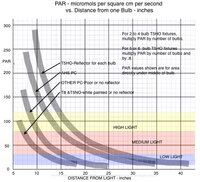The source is plantedtank.net
http://www.plantedtank.net/forums/showthread.php?t=105774
Sorry you are wrong, please don't be disturbed, all patently obvious. As the tubes are generally closer together than the distance off the substrate, there is probably near 90% overlap of their outputs, therefore you need to just multiply the one tube PAR level by number of tubes. This is shown in practice as this graph is from actually measured light levels.
I'll completely disagree on the Me=Wrong bit, light distribution MUST be taken into account when considering those PAR readings - there is only a small light distribution area with those maximum PAR values. If the ATI fixture I found is the correct model, total width was ~ 9.5 inches - going back to that light distribution curve, once you're (your probe) no longer directly beneath the lamp, PAR values drop significantly, eg, at 12 inches (remember the last T5 lamp is located at ~ 9inches), PAR values are now in the 110 range - a far cry from that hypothetical 312 or even the measured 220 - move out 6 inches from the outlier lamps, & PAR is 90 & so on ...
With a single lamp placed centrally over a tank, that maximum PAR range of 40-50 is unlikely to apply to "most" of the tank (assuming a 12in width) - unless you know something that is
not written in this post - I didn't read the 50 pages
😳 ... perhaps the values reported are already averaged over some light distribution area
😕
Also note that 40 - 50 PAR value was for T5HO with "good" reflectors: most fixtures on the market have more of what I'd consider "fair" reflectors.
My T5HO tubes are ~ 8inches apart, it's unlikely that the spectra show a 90% overlap (I don't have access to a decent sensor or data logger) but one can see the shadowed areas change as I physically move the light fixture across the width of the tank (60cm x 45 x 55cm, fixture holds lamps ~60cm above substrate).
There are many repeated experiments like this, all giving same result, but none presented in such a useful handy graph.
I'll stick with Sanjay Joshi & his light distribution curves (which agree with many other similar light distribution curves) - he also includes details on the materials & methods which show a thoughtful process & allow anyone to repeat the experiment.
well its certainly an inaccurate assumption, but that inaccuracy is going to be most pronounced with 6 bulbs, and I don't think your plants are going to particularly care if the deathray above them is ~240 PAR or 312. 20% inaccuracy for a rule of thumb ain't bad, especially for the absolute worst case
Not sure how you determined the 20% ... 200-220 PAR (range measured) ~ 210 (median) / 312 (median) ~ 67% ... I'd consider 1/3 discrepancy to be notable.
If you utilize that pinpoint 220 - 240 PAR maximum which looks to have a distribution of maybe a 1inch circle .... then you're right, I have no comprehension
😉
Sorry Marc for making this so complex
😳
The depth of my tank is really 2 feet, the graph would indicate that plant growth near the surface have too much light & the carpet plants will not have enough. I'm none the wiser.
This is true, as plants approach the lamp, PAR values increase significantly (you can often observe changes in leaf structure, color, speed of growth etc) - if you want good growth on carpet plants, then you need to consider what the PAR values are in that zone, OTOH plants are often more limited by CO2 availability in aquaria rather than light ...
You've not supplied much detail on your tank, it's heavily planted but how long has it been planted?
substrate?
fertilizers?
present light schedule?
no CO2 but what are other water values, eg, ,pH, KH, GH
types of plants?
water change schedule?
cycled filter?
algae crew?
fish?




